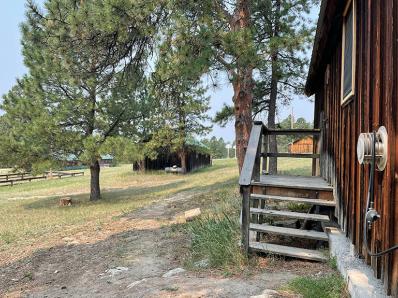Ekalaka Montana Digs
Annually, Burpee Museum heads up research trips looking for clues to our Earth’s past. YOU can join these trips through our Dinosaur Expedition programs to Ekalaka, Montana, in August.
SAMPLE DAILY SCHEDULE
A daily rhythm is soon established at Camp Needmore as participants settle into the field lifestyle of the paleontology field crew.
7:00 am Hot breakfast
Made by the on-site Burpee cook, participants gather in the mess hall for coffee, biscuits, gravy, eggs, or other delicious breakfast items. Dietary concerns will be accommodated, of course.
8:30 am Gather in Trucks and leave for the field
Burpee paleontologists are at camp with multiple off-road-ready pick-up trucks. The team packs the trucks full of supplies for the day, including water jugs and tools. You will ride with the team in these trucks for about 40 min to arrive at the locations for the day.
9:15 am Begin fieldwork
Depending on the daily goals, the team will either prospect for new fossil finds by hiking around known areas or stop and collect microfossils (fish scales and bones, turtle bones, frogs, salamanders, and more) at one of the many GPS-marked microfossil sites, or begin excavating known larger animals.
Break for water
It gets hot out in the Badlands of Montana! Teams are encouraged to have water in their backpacks and take several breaks to reapply sunscreen, drink water, and rest between working.
12:00pm Lunch
Sack lunches packed by the Burpee cook are brought to the field for you by the Burpee team.
5:00 pm Leave the Field
Returning to the Burpee trucks, you will have a relaxing and well-deserved escort back to Camp Needmore to relax, shower, or clean up for dinner
6:00 pm Dinner at Mess Hall
Burpee’s on-site cook provides a hot dinner ranging from tacos to lasagna to a cookout of burgers and hot dogs. Vegan and Vegetarian meals are available.
7:00 pm Research Lecture
Burpee staff provides multiple learning opportunities for the team, including presentations and discussions around local geology, paleontology, and other topics.

Camp Needmore Bath House

Camp Needmore Bath House

Cleaning a Triceratops with a brush

Sorting microfossils in the mess hall
WHAT MIGHT I FIND IN EKALAKA?
The Hell Creek formation contains fossils from the late to mid cretaceous time period. Dinosaurs that are commonly found include the iconic triceratops and T. rex. Burpee also has sites with therapods such as anzu wyliei. Beyond dinosaurs, there are many smaller animals, such as turtles and crocodiles. Burpee also has several microfossil sites that include fish, frogs, salamanders, and much more.
How do I find bone?
Actually, finding fossilized bone is really easy! Bits of bone are seen eroding out of the sides of hills. This is called float and is not typically collected as it has little scientific significance because paleontologists can not usually determine much from the small chunk of eroded bone. To have significance, there needs to be a large amount of bone or key features that can allow scientists to tell the animal species. Bone falling out of the hill is typically an indicator that there is more bone around. Teams look for “float” falling out of the hill and follow it up the hills to attempt to find the source of the eroding bits. A little climb up toward where the float was eroding and falling out can often link to larger and more identifiable bone as well as maybe a full bone or skeleton still buried under the dirt. That is the significant find you will be looking for!
What happens if I find fossils?
Great News! You can help scientists gather information about life long ago! Teams will work together to dig around the fossils with care. Our team will teach you how to do this work. Fossils will be excavated and covered with plaster to secure them for the trip back to Burpee Museum.
How will I know where to look?
Burpee has several GPS-marked locations where we know there are microfossils or larger animals. Burpee teams will bring you to locations with a high probability of finding fossils or sites that already have significant finds identified.
